
He was carrying a bag with the avocados his aunt and uncle had given him, and a pair of sandals he had bought on the other side for his little girl. He was walking along in his rubber boots, as always, across the pastures and fields of high grass that separates the department of Rivas in Nicaragua from the province of Guanacaste in Costa Rica. He’s Nicaraguan but has spent nine of his 34 years living undocumented at Santa Cecilia de La Cruz, in Guanacaste, Costa Rica.
Here, the border is an imaginary line that many like him know by heart, because that’s how they live: between one country and another. They visit relatives on the other side, buy groceries in the neighboring country, cross the border on foot, by bicycle, on motorcycles, on horseback. Anyone else would get lost, but he never does. As he walked, he was thinking perhaps about the rice that he needed to put out to dry in the sun, so that he could plant it the next day. That’s when he saw them.
“When I saw them, I let out a cry: “Ohh no!” I wanted to get away from them, but I couldn’t.”
***
If you study the map from right to left, the natural border between Costa Rica and Nicaragua breaks down at the point where the Rio San Juan veers north. This is the area of Tiricias in the Costa Rican canton of San Carlos, across from the Bartola Refuge on the Nicaraguan side.
After that, there’s just an invisible line which runs through pastures, mountains, wetlands, scrub-brush, houses, and people’s lives. Above all, through people’s lives, their communities. Entire communities, accustomed to receiving health services from Costa Rica and to buying beer or cheap leather sandals on the Nicaraguan side.
For decades, residents of both countries have seen that imaginary line drawn into political scandals and conflicts echoed in the media coverage: from the clashes over navigation along the San Juan River, to the controversial roadway project of Laura Chinchilla’s government, and the 2010 Nicaraguan invasion of Isla Calero in the river.
But the COVID-19 pandemic and the abysmal differences between the two countries in public health management is perhaps the sharpest blade that has ever been used to split these communities apart.
The Voice of Guanacaste teamed up with Interferencia de Radios UCR and Confidencial in Nicaragua in a two-nation investigation to understand how life now looks to the families who live to the north of the Costa Rican communities of La Cruz, Upala and Los Chiles, in this new “normal”, along this new border.
***
***
Estela
A back road of black earth bordered by irregular clumps of houses leads us to the home of Maria Estela Hurtado. The place itself is called “The Alley”, and it’s one of the hottest points of entry for migrants trying to cross from Nicaragua into the north of Costa Rica.
Maria Estela is the very last resident on the Costa Rican side of Penas Blancas, before the road leads on to the Nicaraguan side of the community. Or, looking at it from the other side, the first house the migrants will encounter when they enter and leave, leave and reenter.
Very early in the morning of this Friday in June we find her sweeping the hard dirt of her patio, surrounded by piles of firewood and dogs with their ribcages showing. A little girl picks up a smaller girl, who in turn holds up a doll. The smoke smells of tortillas. Just beyond, there’s a broad view of the invisible shoelace that is the border with Nicaragua.
Fifty meters separates Estela from her native Nicaragua. Along that route lie discarded shoes and forgotten flip-flops that could tell a thousand tales. Today, there’s absolute silence along the path which, up until a few months ago, was filled with dozens of people flowing from one side to the other.
At 56, Estela has never experienced anything like this pandemic. Like any other inhabitant of planet Earth, she divides her years in two: before the disease and during the disease.
For example: before COVID, there were good days in which more than a hundred migrants passed through, and she sold tons of rice and bean plates, cups of coffee, soda, or peeled oranges. This helped with the water and electricity bills which have reached nearly US $155 lately. Even though she cooks everything over a wood fire, Estela passes electricity to her son’s house next door via an extension cord. “His little girl is sick, and I feel bad that they’re in the dark, with the mosquitos. They only use it for one light bulb and a fan.” She also lets another niece use her outlets to charge the family’s cellphones and a little lantern, since they don’t’ have electricity.
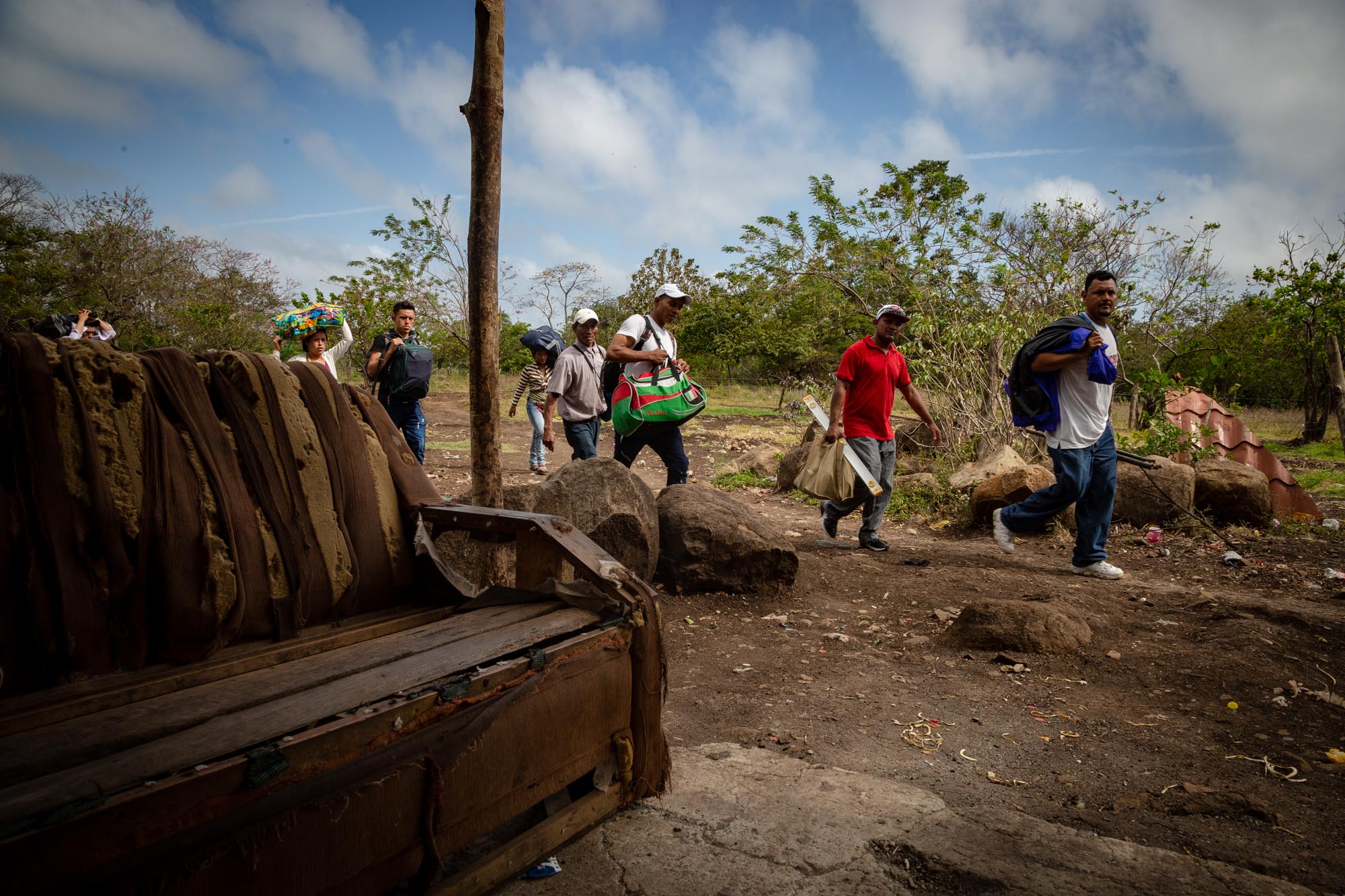
This is what the flow of people in front of Estela’s house looked like during February. Along this dirt road known as “the alley”, dozens of migrants crossed daily from Costa Rica to Nicaragua and vice versa. Photo: César Arroyo.
In these times of pandemic, there are a lot of things that Estela doesn’t like. They treat her Nicaraguan compatriots badly, for example, and the patrols have converted the dirt alley into a roller coaster of filthy clay. Then there’s the fact that her neighbors Sara and Jose can’t go anywhere, because they don’t have papers.
Sara and Jose can’t even leave their house. Dona Estela takes us to their home, diagonally across from hers. They’re afraid of COVID, but more than that of being detained, because if the police stop them, they have no way of proving that she’s Costa Rican and he’s a legal resident. This worries them much more now that the police are stricter about looking for migrants that have crossed over illegally from Nicaragua.
Sara Maria Santana is Costa Rican, but she doesn’t have an identity card because her mother couldn’t register her formally when she was born. Her husband, Jose Martinez, is Nicaraguan and has lived here for thirty years. Unfortunately, he lost his wallet, and with it his residency document. Jose says he hasn’t had enough money to apply for a new one.
Without their documents, they can’t receive state medical assistance, even though both suffer from diabetes and hypertension. If they have a headache, they buy a pill from the nearby shop, and pray for it to go away. Now, even going for that pill has become complicated. “It’s hard with the [border] operations… if they grab you while you’re going by and you’re without documents, then they say that you’re coming from Nicaragua,” Jose explains.
Despite everything, Dona Estela is happy that the police are arriving so frequently, because the spate of robberies that targeted the migrants entering from the hills has ended.
That’s one of the consequences of Costa Rica’s “Secure Borders” operation, which has brought together all of the nation’s police forces (Judicial Investigations Department, OIJ, Immigration, Border Patrol, Coast Guard and even new police recruits from the National Academy) to strengthen the porous 309 kilometer (192-mile) northern border. Erick Morales of the border police, steps out of his patrol car with enormous fat tires just in front of Estela’s house. With him, we walk right up to the invisible border line, and he explains that he has confiscated cheese, medicine and even cyanide here in the last few days.
“It’s a passage that, at one time, the Nicaraguans used when there was no police presence. Yesterday we found 440 pounds of cheese in four sacks,” Morales explains.
“They take advantage of the moments when our officers are in another sector, or when we’re on our lunch hours… Right now, just those of us from the border patrol are taking in 11 people [under arrest] for illicit human trafficking,” he adds.
Around Penas Blancas, they’ve turned back the majority of the irregular migrants over the last months: 7,106 of them, from March 18 through June 7th. Along Costa Rica’s entire northern border, the number of those denied entry rises to 14,268.
According to both Dona Estela and border patrol agent Morales, now there are fewer attempts at crossing, but they’re more risky ones. They don’t do it any more in full daylight, but in the nights and early hours of the morning. “You can hear the dogs barking over there where they’re going,” says Dona Estela. As they go, they cut the wire fences encircling Manuel Cerda’s farm, the first farm on the Nicaraguan side of Penas Blancas.
As a result, not long ago a dozen of Manuel’s cows escaped. It fell to Manuel’s son to run out and cross over to the Costa Rican side to herd the cattle back home. All this took place before the eyes of two public security officials, who looked at each other, confused and entertained. “This happens all the time; we have to go fixing the fence all the time,” Cerda told us.
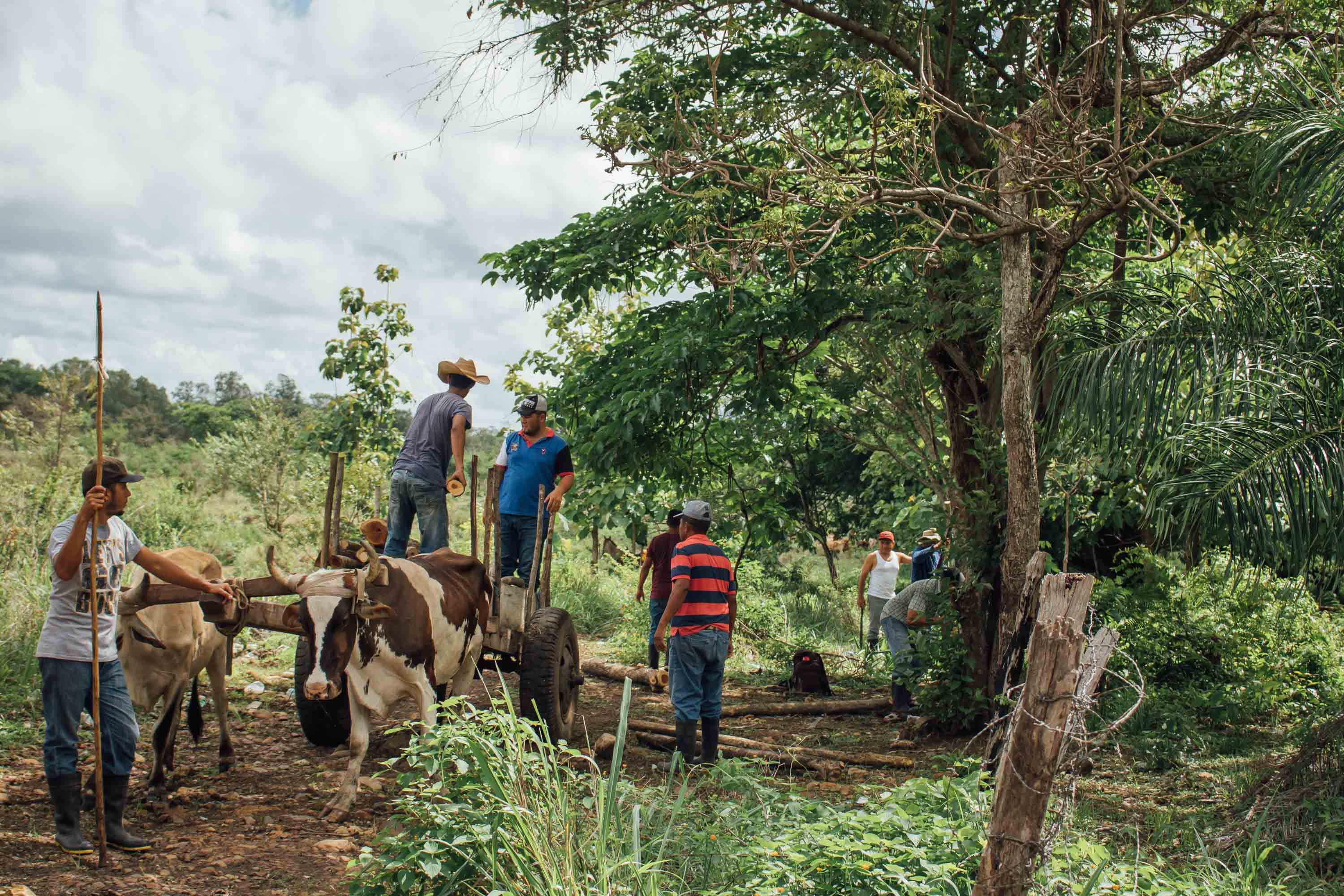
The owners and laborers of a Nicaraguan farm that borders Costa Rica repair the fence that separates Rivas from Guanacaste. Manuel Cerda, owner of the farm, affirms that his cattle escape almost daily to the Costa Rican side because people who cross them cut them constantly. Photo: David Bolaños.
Dona Estela is very sure that she can’t be giving charity to anyone. Her neighbors ask her how she’s going to manage, with such a big heart, to refrain from helping the Nicas who come fleeing Covid. Without being aware of it, she describes the greatest turning point of her years in Costa Rica.
-“One day, a man got very angry at me. It was around 5:30. There were some rocks there, and the man sat down on one.
-“Look, Mister, I’m sorry, but please keep going. There’s the road and may God be with you.”
-“But I know you.”
-“Yes, I know you too, but I don’t want you to get me in trouble, the way the laws are. I don’t want you to get me in trouble with the law and with the diseases there are.”
“You should have seen it! Later that man moved on, and I was left with something heavy in my heart, because we’re human, we’re all human, and everyone one who comes does it because they have needs.”
Doña Estela’s story is interrupted by a boy coming to buy tortillas. She yells at her children to keep the door open. They yell back something that only she understands, and they give the tortillas to the buyer. Her grandchildren also shout and run out to the patio to see the small plane that flies over us, leaving us half deaf. Dona Estela doesn’t even flinch. “They’re always flying by to check. They’re watching. It’s the police,” she says, and continues sweeping the dirt yard.
Delmer
Following the imaginary border line, we head southwest, from Penas Blancas to the Santa Elena village, in the Costa Rican canton known as La Cruz de Guanacaste. It’s 11:50 AM. Erick Morales directs us to the “sector” of Don Claudio’s farm, one of the most difficult points on the border for the police, for the mundane reason that there’s no cellphone service.
“It’s difficult for the people who collaborate with the police authorities to report to us,” complains Morales. Twenty-nine years old and with his head completely shaven, Morales maintains his calm composure throughout the time talking with us.
A short path surrounded by pastures brings us to another group of police from diverse agencies: Migration, the Border Patrol and the Public Security Forces. They’re surrounding Delmer Zuniga, a youth wearing rubber boots and a look of utter resignation. Delmer sits amid the tall grass, with the bag of avocados and newly purchased flip-flops beside him. He wears blue gloves on his hands and a white face mask.
Morales explains that when Delmer saw the officers, he tried to go back. “But then the colleagues in the back part caught up to him and succeeded in capturing him.”
Delmer admits that he doesn’t have residency papers, but he affirms that he has family in Santa Cecilia. “My daughter’s been there since kindergarten, she began her schooling there.” He also says that the pandemic has hit him hard economically, because he works “on his own” and has no one to sell the things he produces to.
He also maintains that doesn’t go up any further into Nicaragua because he’s afraid he’ll get infected. “I’m telling you that I’m not going up over there, because – dang – God forbid!”

Delmer, a Nicaraguan farm worker, was detained on Friday June 12 for entering Costa Rica in an irregular manner through the village of Santa Elena in the Santa Cecilia district of the canton La Cruz de Guanacaste, via a dirt road that is totally surrounded by open pastures. Delmer affirmed that he resides and works in Costa Rican territory, but that he crossed over to Nicaragua to buy a pair of flip-flops and to pick up some avocados that he’d been offered. Photo: David Bolños.
The borderline itself is dozens of meters further down. We head down there. Sitting in his small house, Ariel Umana watches us from the other side, laughing. An open gate divides the two pastures and the two countries. We present an absurd scene, shouting because we can’t go any closer.
Ariel says that where he lives, everything is calm and “normal”. He affirms that he doesn’t use a face mask because “the virus is mostly in town”, and he doesn’t want to go out to buy anything and make it all worse. In this house, he tells us, a young woman used to sell sweet drinks to the migrants who would pass through from time to time. Irregularly, because it’s an unauthorized point of entry, but fairly frequently, because no one was going to go all the way to Penas Blancas to enter Costa Rica and then come back 25 miles, even if they could do so.
A sign is painted on the top slat of the wooden gate: “1500 to cross”. We ask Ariel what the motorcycle lying near his feet is for, and he tells us he uses it to get to his field, where he plants beans. The police later laugh at his assertion. “There goes the farmer,” they say when Ariel starts up the motorcycle and takes off, after watching us moving away. Back at the pasture where we found Delmer, Morales explains that the police are constantly closing the gate, but later they come back and find it open again. He also explains that 1,500 [Costa Rican colones, about US $2.58] is the cost of a motorcycle ride from this pasture to the village of Santa Elena.
Still sitting in the grass, Delmer watches our return. His eyes look angry, his skin is toasted. In theory, his destiny is in the hands of the Migration officers, who will probably refuse him entry and turn him over to the Nicaraguan authorities, Morales explains. But in Delmer’s head, there’s only one possible way out: “No matter what, wherever they drop me, I’ll come back again, because, heck, I have nowhere else.”
Victoria
The last house in La Cruz de Upala in Costa Rica’s Alajuela province has one door in Costa Rica and the other in Nicaragua. A Nicaraguan flag waves in the air, while on the ground three orange cones mark the line that, since March 18, no one can cross.
From here, the Costa Rican town of Upala is as close as Nicaragua’s Lake Cocibolca, each about 20 minutes away. “Here, you can get up in the morning and say, “Okay, I’m going to Nicaragua”, Lieutenant Jason Padilla tells us in the patrol car. He says this in the present tense, as if you still could.
Padilla is the chief of the 240 police officers in Upala. It feels like all of them are accompanying us en masse, but we’re really only surrounded by a small bunch of officials, sheathed in masks and dying of the heat.
“What we do is to station many small groups of police along certain points, so as to keep the border contained. We also establish random checkpoints along the highway, at the exits from the cantons, to catch the ones who filtered something past us or got away with something. We manage to locate them at the checkpoints. In the morning, we also make checks of the buses,” Padilla explains in the patrol car.
The Nicaraguan soldiers behind the cones are carrying their AK-47s. They stand immobile for a few minutes and take our pictures with their cellphones. They observe us.
At the southernmost point in Nicaraguan territory is Dona Victoria’s house. A simple wooden house, with hammocks, and chicken coops, plus two dilapidated freezers that once upon a time were used for selling fish to Costa Ricans and foreigners.
“Doña Victoriaaaaaa!”
Padilla calls to her as to someone he’s very comfortable with. Dona Victoria’s door has the numbers one to ten drawn there in a childish scrawl. Her patio looks out on marker number five of milepost 13, another border symbol that previously meant very little and now means everything: the severing in two of a transborder town that shares a name, neighbors, a neighborhood store, family.

A concrete boundary post marks the border in the yard between two houses, in the town of La Cruz de Upala that appears on the map as “Nica Mall” due to the commercial exchange that was common before COVID. In this small village, crossing between two countries was as easy as opening the door and going out to the backyard. Photo: David Bolaños.
Doña Victoria doesn’t go out and won’t be doing so. “Sometimes they don’t go out because the soldiers scare them, says Padilla. However, the kids in green uniforms have already broken the tension. One goes to buy cigarettes, the other leans against the wall.
“Before, they’d come here and get into military formation, with their weapons and all. My colleagues who are here had to utilize a lot of emotional intelligence, manage their emotions, because we must avoid problems,” states Padilla.
Josue Sanchez is one of those people that Padilla was referring to. He maintains his rigid posture until we approach him to converse. He tells us that he’s in charge of the patrols in the zone, because he’s lived in Upala for nearly his whole life, except when he went to study. He’s also worked in Tablillas, and in Penas Blancas. “I’ve had the pleasure of working in all three of the three border towns here,” he says. He seems proud of what he’s achieved. He’s been interviewed on Channel 6, Channel 7, in the pages of the Upala news. It’s almost always about the operations when they manage to capture someone right at the border.
Whereas Morales noted that the migration is ever more nocturnal, Sanchez adds a new element: it’s ever more dangerous.
“[At the border] what you’re going to find is mud, rivers, brush, very high mountains. There are some places where you have to make your way by opening a path through the tall seed grass. There are paths that no one has used for a long time, and they’re overgrown.” The patrol may cover 8, 10, 13 miles. That takes three, four or five hours.
Sanchez goes on to talk about the day before, which was especially difficult because he had to pursue a group of Nicaraguans along the parallel. They had clear intentions of crossing. “The water came up to here,” he says, indicating his thigh. In the end, they managed to intercept the Nicas and tell them that they couldn’t cross the line, and the Nicaraguans desisted. Mission accomplished. But now a rash has broken out all over Sanchez’ body, and he has to ask Lieutenant Padilla for permission to go to the clinic and have it checked.
Although the quantity of migrants has diminished according to all the officials, one thing they have begun to note in Upala is the trafficking of people by taxi drivers and other transport vehicles. Just the night before, they detected one, in a red taxi, Padilla tells us. “We have information that there are people who are organized with vans, informal taxis and registered taxis, that are coming to the border line, taking advantage of a moment of neglect.”
Later on, a coyote who identifies himself as Miguel will confirm via telephone that there are ever more desperate people in Nicaragua begging him to bring them over to the Costa Rican side.

This gate functions as the dividing line at one of the three farms which the Costa Rican Public Security Forces must cross in order to reach Marker 13 at one corner of the Nicaraguan-Costa Rican border. This sector lies within the canton of Upala. The same road is also used for irregular border crossings between the two countries. Photo: David Bolaños.
In Nicaragua, the authorities have offered very little data about the pandemic. They’ve even been questioned by the Pan American Health Organization. There’s no data on COVID-19 tests, and the official numbers of positive cases and deaths from the virus fall way short when compared to the reports from independent civil organizations and journalists’ investigations.
President Daniel Ortega has refused to decree a national quarantine or any measures of social distancing. On the contrary, his government has promoted mass activities such as marches, parties, concerts and fairs. “If work is stopped, the country dies,” was Ortega’s justification. Alleging economic reasons, his government has insisted on keeping everything “normal” in a country that is now in its third year of economic recession, stemming from the sociopolitical crisis that broke out in April 2018 and still persists.
“Before, they’d come and go without calling or anything, and they’d do it on their own because, obviously, the crossing was easy, Miguel would later explain.
“One man decided to pay the 50,000 [Costa Rican colones – approximately US $86], but he told me that just as they were leaving the square, they grabbed the young guy (the coyote driving). The man got out and ran across the pasturelands, and he says that later he walked and walked. Some people helped him, and later he had to cross through some areas of just brush. He called me when he reached Ciudad Quesada, saying that he had to go through the inside roads to get to San Jose. It took him two and a half days to arrive, and they almost got him.”
“Costa Rica now has a wall, which is what Donald Trump wants for the migrants,” Miguel feels. He assures that in his community in Nicaragua, some have died from COVID-19. “Since it’s a small place, everything is known here, even though the government wants to cover things up.”
*****
From the first supermarket across the border on the Nicaraguan side, the sounds of a cumbia blasts out to our ears in La Cruz de Upala, with no respect for the border symbolism. If we close our eyes, it seems like the better times, when any Costa Rican could cross over to the other side merely by showing their identity card to the soldiers. Then, they could go have a few beers or buy clothes on the Nicaraguan side. Those were the days when the tourists’ cars filled the vacant lots on both sides of the road, and the lots held signs about 1,000 colones to park and public bathrooms. On the map, this point appears as “Nica mall”.
As Padilla recalls these times, he seems to savor the memory. He lives in a complex dichotomy. On the one hand, he feels that his work – that begins at 5 am and ends at midnight from Monday to Friday – protects Costa Rica from the invisible and lethal virus. But on the other, he knows that this work is completely destroying the lives of these people. “Their commercial activity has dropped 100 percent,” he recognizes.
Perhaps for that reason, he’s so confident when we ask him what will happen when there’s an emergency on the other side and they need Costa Rica’s Red Cross, or when the classes begin again and the kids need to cross over to go to school. “You’d need to let them in or see what kind of controls to have with them, because we’re not going to limit their access to education,” he says. We start with the idea that human life is first above anything. They’ll have to be attended to, they have to,” he repeats.
Maritza, Idalia, Mercedes, Martin
If COVID-19 had drawn in ink the border between Costa Rica and Nicaragua, the line would pass only a few inches from the feet of Idalia, which are planted between her porch and the sidewalk, while a photographer from this investigation takes her picture. In front of her stretches a gravel street which they can’t use, since it belongs to Costa Rica.
Idalia says that she had to go pick up some medicine at the health center in Costa Rica, and they let her go, but she doesn’t know what will happen next time. “Now I see that things are getting stricter, and so, we’ll see. I have an appointment this month.”
On her side, the town is called Penjamo and belongs to the municipality of San Carlos in Nicaragua. On the other side, it’s called Mexico and is part of the Upala canton. Since March 19, there’s a police guard post from which they constantly watch the activity in the zone. Crossing the street had never been so illegal.
Maritza comes out of Idalia’s shop and talks with us with her back turned, fearful that we’ll take her picture. “I can’t show my face, because we go over there and then we might encounter the police.” They continue going because there’s no potable water [on the Nicaraguan side], only well water, so they have to bring back water to drink. They do it in the wee hours of the morning, fearful of being seen.
A few houses further down to the right, Marlene Mairena is cooling off with an open fan. She assures that they “cut the trips” by motorboat that link her town to the Nicaraguan side via the Papaturro river. She tells us this as a way of explaining that in her village there’s no COVID-19, and because of that there’s no reason to be afraid of the Nicaraguans there. And, of course, they’re careful. Her husband Wilfredo Meza and herself are both older adults and for that reason, they haven’t gone back to Managua to bring merchandise. Because of that, and also because they aren’t selling anything since the pandemic began. “Now we sit here watching the street, and everything is still.”

Martin manages a clothing and shoe store right by the border between Costa Rica and Nicaragua. Although his store is in Nicaraguan territory, the street in front of his business is on Costa Rican soil. Photo: David Bolanos
“Stillness” is a good way to describe what Martin Rios experiences during a large part of his day. Martin, 61, lives alone at a place that he himself built three years ago. Facing the forbidden street, an enormous door gives a view of the clothing he sells. Meanwhile, he sits, as if waiting for some customer, who is never going to arrive. “For example, this is worth 9,500; this 7,000… He walks around the shop with the gray floor and tells us that he hasn’t sold so much as one blouse in a month and a half.
Business, Martin explains, very rarely comes from the Nicaraguan side. “We sell something, but only a little.”
Martiza is more worried about the disease than about business. So that when she saw that the situation in Nicaragua was getting ugly, she went to talk to those who carry passengers along the Papaturro river to have them stop the boat trips. She asserts that now there’s only one departure a week.
“Because of that, we’re healthy,” she affirms. The next phrase she uses sums up all of the abandonment that we find along the cross-border towns. “If we here get sick, Costa Rica will come and put out yellow tape: ‘Caution, Nicaraguans with Coronavirus.’ Meanwhile, there in Nicaragua…they’ll just let the buzzards eat us.”
—–
“The Drawn Border” is a binational investigation carried out jointly by La Voz de Guanacaste, University of Costa Rica’s Interferencia and Confidencial of Nicaragua. The video report was shown on Sunday June 28, and a podcast version was aired on Monday, June 29.
Reporters: Cindy Regidor, David Chavarría, Noelia Esquivel, María Fernanda Cruz
Photos: David Bolaños, Sebastián Avendaño
Videos: Cindy Regidor, Sebastián Avendaño y David Bolaños
Text editing: Arlen Cerda, Gabriela Brenes, Hulda Miranda
Sound editing: Marco Cordero
Video editing: Claudia Tijerino, Sebastián Avendaño


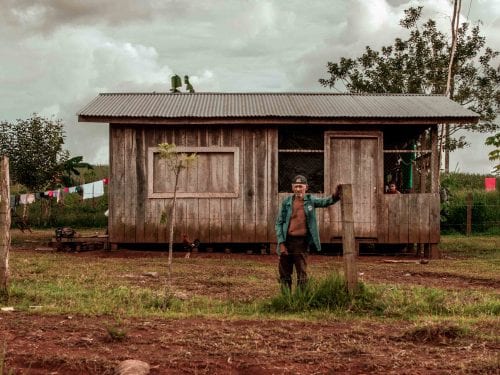
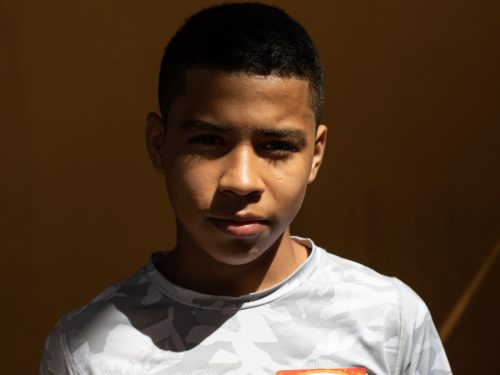
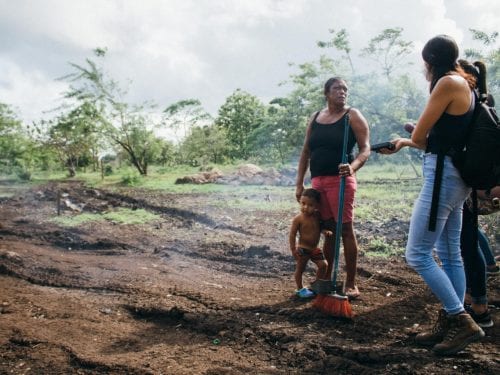

Comments